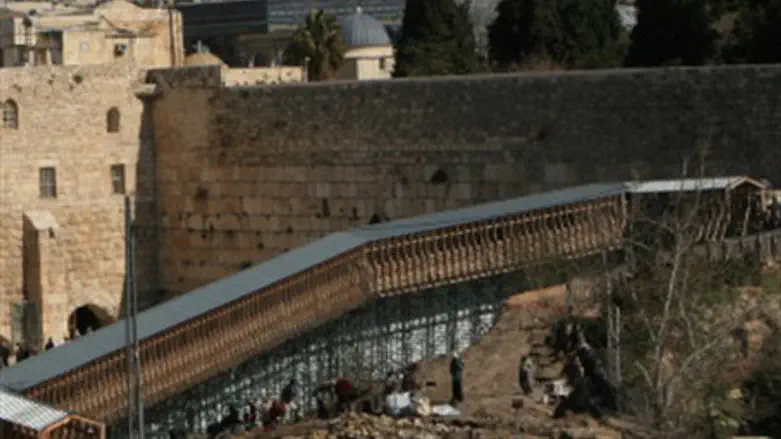
Less than two weeks after construction began, and before it could be used, Israeli police began dismantling the new bridge to replace the unstable wooden walkway to the Temple Mount on Wednesday.
The new bridge was announced two weeks ago, and would have replaced the shaky wooden construct of the bridge leading up to the Mount near the Rambam (Mughrabi) Gate in the Western Wall Plaza.
Prime Minister Binyamin Netanyahu (Likud) has ordered the bridge to be dismantled, however, due to pressure from the Jordanian Royal Family, according to Haaretz.
A senior Israeli official said that the construction of the temporary bridge was done by local officials, and was known to the Israel Antiquities Authority (IAA) and the Western Wall Heritage Foundation, but not the Jordanian Waqf Muslim Authority - and without the Jordanian government's approval.
When the Prime Minister's Office (PMO) learned of the establishment of the temporary bridge - from protest from the Jordanian government and royal family - it began investigating the legal ramifications of the issue with the Jerusalem Municipality and the Western Wall (Kotel) management.
The senior official said that Jordan sent a message to several diplomatic channels, through the Ministry of Foreign Affairs and other means, in which it said the construction of the temporary bridge "offends many sensitivities to the kingdom, and could undermine its stability."
Jordan made it clear that various factors in the Kingdom would try to take advantage of the occasion to argue that Israel is trying to "make changes" on the Temple Mount area.
"In the face of Jordan, and the fact that there is little doubt as to the [lack of] necessity of a temporary bridge, and given that the construction was made without coordination and without the approval of the Prime Minister - it was decided to dismantle it forthwith," the official said.
"The Western Wall Plaza is the responsibility of the Prime Minister due to these very sensitivities. We wanted to avoid a situation now, at this time, when Israel is being blamed across the Middle East," he added.
Who rules the Temple Mount?
The Jordanian Waqf has had de facto rule of the Mount since the 1967 Six-Day War, and keeps an iron fist on the Temple Mount and its activities.
The Jordanian government has threatened action several times over what the Waqf and other groups claim is the "Judaization" of Judaism's holiest site.
In April, Jordan summoned the Israeli ambassador to the country to protest the “Israeli provocations” on the Temple Mount. This took place after Israel closed the Mount to members of the Waqf as a result of riots by Arab youths.
Several days earlier, Jordan urged the United Nations Security Council to end Israeli "escalation" at the Temple Mount after it was opened to Jewish visitors.
Previously, Jordan threatened to revoke its 1994 peace treaty with Israel over a historic debate in the Knesset about providing religious freedoms and prayer rights for Jews on the site.
The only entrance for non-Muslims
Controversy over the Rambam/Mughrabi Bridge began in 2004. In winter of the same year, the old embankment collapsed in the plaza of the Rambam Gate's entrance to the Temple Mount, following an earthquake and inclement weather.
The Mughrabi Gate is the only one that serves non-Muslim visitors to the Mount, and the one security forces use during the frequent outbursts of violence there.
Following the first bridge's collapse, Israel quickly built a temporary wooden bridge on metal pillars, in order to replace it with a permanent stone bridge later on.
However, the plan quickly drew international condemnation, with opponents claiming that Israel is in violation of the status quo on the Temple Mount.
Terror groups, including Hamas and the Islamic Movement in Israel, claimed that the purpose of the program is to take over the Temple Mount and cause damage to mosques, and threatened to respond with violence if the work on a permanent structure would begin. Jordan and other countries threatened political crisis.
On the other side, Jerusalem city engineers determined that the existing bridge is unsafe for police and others and should dismantled. In the end, the government - under international pressure and fear of violence - decided to shelve the plans for a permanent bridge, and be content with the renovation and reinforcement of the temporary wooden bridge.
At the same time, archaeological excavations were carried out under the bridge - and years-old reports indicate that the structure, which was never meant to be permanent, is growing shaky.